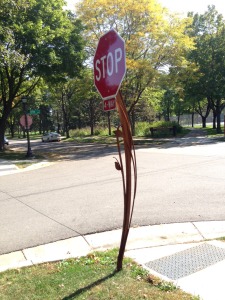Taxpayers can’t get a ‘break’ with St. Paul’s artsy stop signs

By Tom Steward | Watchdog Minnesota Bureau
ST. PAUL, Minn. — St. Paul may be predictably progressive, but the powers at City Hall enthusiastically embrace the “1 percent.” The 1 percent, that is, of costs automatically taken off the top of local government construction projects, under a city ordinance mandating taxpayer-funded public art.
Form counts as much as function in city infrastructure projects. “The city council believes planning and development decisions should give aesthetic and social value equal weight with any project’s functional and economic values,” according to the Public Art Ordinance Program Guidelines.
“The city does not directly employ any artists. Any artists commissioned to create work under the aegis of the public art ordinance are under contract to the particular city department that is managing a capital project that is subject to the ordinance,” said Dave Hunt, marketing and media relations coordinator for the St. Paul Public Works Department.
Embedded in public works department offices and equipped with taxpayer-provided phones and computers, two artists-in-residence, paid by the nonprofit Public Art Saint Paul, collaborate with city engineers and architects on capital construction projects — from stairways to stadiums.
The most visible publicly funded art on display stops drivers and pedestrians in their tracks — by design. Dozens of newly installed floral-themed stop signs, commissioned by resident city artist Marcus Young, elicit double- and triple-takes.
“Marcus concluded that, if a stop sign post is a matter of life and death, it is even more important that the stop sign post be beautiful,” according to Art Place America. “… It should speak to something beyond simply maintaining our life; that the stop sign post presented an opportunity to create something that keeps our bodies safe while nourishing our souls.”
The $110,000 public arts project features traditional stop signs atop curved rusty iron posts shaped like stalks that sprout metal petals, leaves and floral motifs designed by artist Lisa Elias. The floral signs averaged about $1,000 apiece, including administrative, production and installation costs. Typical stop signs cost about $250 to replace every 10 to 15 years and don’t generally need new posts, according to MnDOT.
A master list of projects undertaken since passage of the 2009 ordinance indicates $1.3 million in taxpayer funding has been budgeted for public art works incorporated into infrastructure projects such as bridges, boulevards, buildings and public places. A 79-page technical manual lays out the policies and procedures for artists to follow.
“Artists should be involved from the earliest stages of conceptual planning, and continue through project design and implementation,” according to city guidelines.
Case studies posted online show budgets up to $50,500 for artwork on a bridge, $90,000 for a digital media set-up at a community and recreation center and $170,000 for creative enhancements at the new St. Paul Saints’ stadium.
“The ordinance has the support of both the mayor and city council, and we – Public Works — work in close partnership with Public Art Saint Paul and the City Artist in Residence to meet this obligation, which has proved very popular with residents and visitors alike,” said Hunt in an email.
THE 1 PERCENT: Some $1.3 million has been diverted from taxpayer funded city infrastructure projects for esoteric stop signs and other public art works.
A Public Art Ideas List catalog contains examples from other places and encourages taxpayer-funded “social practice public art” performances that address social justice and environmental issues.
Even wet pavement presents a canvas, with nearly $50,000 spent cementing residents’ poetry on sidewalks. The Everyday Poems for City Sidewalks initiative has immortalized hundreds of compositions in concrete. “A dog on a walk is like a person in love. You can’t tell them it’s the same old world,” goes one example authored by Pat Owen.
ARTSY INFRASTRUCTURE: Nearly $50,000 has been allocated from St. Paul public works projects for hundreds of citizens’ poems cemented into new sidewalks.
This month the city expects to finish installing the nearly 100 “public art stop signs” designed to attract more than a passing glance to this stalwart of traffic safety.
“I do appreciate walking in the neighborhood and the beauty of the stop signs. I can tell they’re all hand-made,” said Andrea McCormack, a St. Paul resident and artist who has not worked on any city projects. “You can tell that each one is individually made. They’re beautiful that way, too.”
But don’t let the frilly features fool you.
“We subjected the signs to a year-long test to evaluate their durability, and the test results gave us no cause for concern as to how well the signs will hold up over time,” said Hunt. “Should the signs be damaged in any way, we have a few spare art posts, but once those are used up, we would replace with a standard sign.”
Still, some exhibit less appreciation for the art of traffic control. “It is heartening when I occasionally discover that it is not just me who takes a good look around our beloved and ancient river town and wonders what in God’s name has become of us,” wrote columnist Joe Soucheray in the St. Paul Pioneer Press.







